The ‘Good’:
A small news item appeared recently in Dawn which captured the imagination of quite a few people. The Central Development Working Party (CDWP), a constituent of Government of Pakistan, on September 17, 2008, approved 51 development projects and among them was also included the approval for Karachi Circular Railway.
The ‘Bad’:
On September 23, 2008 another news made it to Dawn that put reality back to the forefront that project still needs approval of Executive Committee of the National Economic Council (ECNEC) and so far it is not even on their agenda to discuss.
Despite this hurdle, I am still staying positive because this project was all but dead since 2006. Atleast we have now moved a step forward.
and The ‘Ugly’:
Many of our readers may know the Karachi Circular Railway (KCR) had been in operation since 1969 and got closed down in 1999 after running into huge losses. Numerous paper and political statements have been made since then for the revival of this project but to no avail.
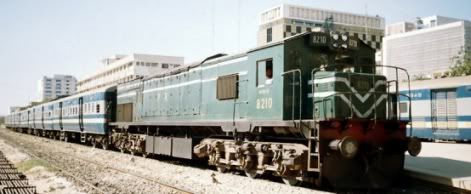
The above photo is courtesy of Adnan Zafar. It shows # 8210 which is a GMU30 (General Motors Universal, 3000hp) locomotive ready to pull a KCR train out of Karachi City Station in 2007.
The downfall of KCR had started in 1980s and by late 1980s only token trains were running. So much so that by early 1990s Railways started to run up-country express trains on KCR loop just to keep its infrstructure from getting scavanged. Chenab Express was run for a while from Manghopir Station and Tezrao from Gilani Station.
The experiment of running of Express Trains on KCR loop failed. The reason was lack of patronage as well as there were no washing lines or security facilities at KCR loop stations. After these trains ran their daily run, they were taken to Karachi City station for washing and security reasons.
The Garbage Train on KCR Loop:
In mid 1990s, another novel experiment was done on KCR loop. Karachi’s Metropolitan Corporation started using KCR’s loop track to collect trash from the whole city. It was called ‘kooRa’ (Garbage) train and it consisted of flat freight cars. Solid Waste Collecting trucks used to bring city trash to KCR stations, where it was loaded on to ‘kooRa’ train and then taken to solid waste dumping areas near Pakistan Steel Mills. This project also got stalled after dumping of city trash in rural areas became a political issue.
Partial Revival of KCR in 2005:
After 6 years of closure, KCR was partially revived. On March 8, 2005 it restarted its operation on a limited scale. 5 up and 5 down trains were started on main line with the longest route between Karachi City and Landhi Jn. The loop track remains closed to this date.
21 bogies to comprise 3 rakes of KCR were refurbished at Moghalpura Workshops in Lahore and sent to Karachi to restart the service.
Following nine photos were taken at Karachi City Station on March 8, 2005 – the day of partial revival of KCR by one of my good friends Syed Mazhar Hassan whose company provided the automated/mobile ticket dispenser units for the service.
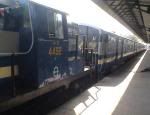
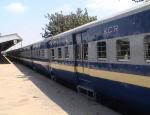

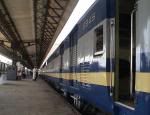
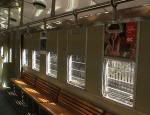
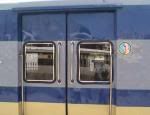
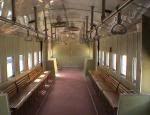
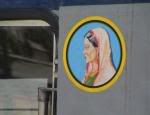
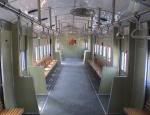
The Locomotive of KCR:
One locomotive #4483 was also rehabilitated and painted anew for the revival. Pakistani designation of this loco is ARU20, which means this is an ALCO rehabilitated 2000 hp model. ALCO stands for American Locomotive Company. Over the years, KCR trains have been pulled by all sorts of locomotives but ALCO’s ARU20 series has known to become the KCR engines.
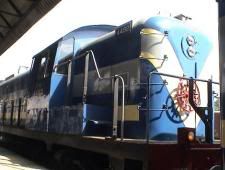
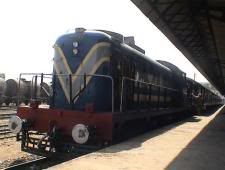
The Capacity of Proposed KCR Network:
The 50 km railway project will have 19 underpasses, 3 overhead bridges and 23 stations in the city. The Circular Railway would carry 689,000 passengers daily through 246 trains. On average 22 Up and Down trains will be operated every hour. The frequency of trains at terminal stations in proposed to approximately one train every 3 minutes. The trains will be operated at 6 minutes interval in either direction at a speed of 100 Km/hour. Every train will have a capacity of 1,276 passengers.
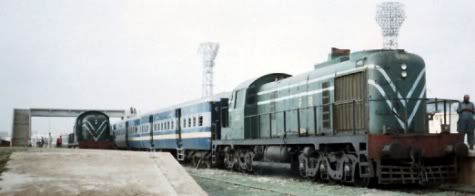
The above photo is courtesy of Adnan Zafar. It shows two KCR trains at Wazir Mansion Station in 2007. Flood Light towers of Peoples Stadium in Lyari are also visible in the photo.
The project envisages dualization of abondoned KCR loop (30 Km) with modern signalling system and grade separation, provision of two dedicated tracks along the main line from Karachi city to Drigh Road Station (14.5 Km) and Link to Airport’s Jinnah Terminal (6 Km).
The Fare:
The fare for the system has been proposed as 85 paisas per kilometer.
How Much Will it cost?
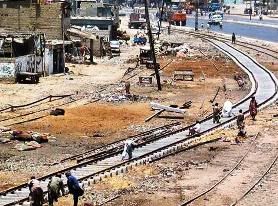 The CDWP approval amount for the project is Rs 52.372 billion which also includes foreign funding in the amount of Rs 39.257 billion. The Government of Japan would provide a soft loan of to cover the foreign funding amount at 0.2% interest which would be payable in 40 years.
The CDWP approval amount for the project is Rs 52.372 billion which also includes foreign funding in the amount of Rs 39.257 billion. The Government of Japan would provide a soft loan of to cover the foreign funding amount at 0.2% interest which would be payable in 40 years.
The photo to the right shows track rehabilitation work going on between Wazir Mansion station and Port Trust Station in 2008.
What About those 26 Level Crossings?
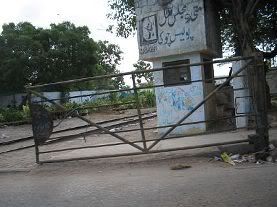 One major hurdle in the revival of KCR has been the presence of 26 level crossings where the KCR tracks cross major city roads.
One major hurdle in the revival of KCR has been the presence of 26 level crossings where the KCR tracks cross major city roads.
I took the photo shown to the right in June 2005. It shows KCR level crossing in Gharibabad just west of Liaqatabad Railway Station.
Since the track is also circular it cleanly cuts through the major commercial areas of the city. This was probably ok for the traffic loads of 1980s and also when train frequency was 1 per two hours. But to sustain a frequency of one train per 6 minute in each direction would have kept each of these level crossings closed for most part of the day. This would have sent the city into riots the next day as nobody can imagine road traffic in Karachi stopped at choke points for a long duration.
According to proposed plan 22 out of these 26 level crossings will now get underpasses or overpasses built on them. Therefore I persam very glad to note the current plan calls for building 3 overhead bridgesand 19 underpasses where the track crosses the roads.
So Will KCR Revival Help Karachi’s Mass Transit?
May be not in its present proposal form BUT it is a step in the right direction so I am happy to see it move forward. Here is why I doubt the vitality of the project. If you just look at the map of KCR Loop below (the lines in blue color), it will become obvious that a circular mass transit only helps people move in circles. A circle doesn’t give you the shortest route from point A to point B. It seems to avoid the main business centers of the city which are located on Sohrab-Goth to Merewether Tower alignement.
The map above is courtesy of Sridhar Narayanan. As far as I know he is the first person to digitally map KCR network (2003). His map has been widely copied. Click on the map to get a larger and much better readable view.
Therefore in my humble opinion, reviving the loop may be first step but then new spurs have to be created to make it really useful.
How Did Karachi Mass Transit Plan (KMTP) Envisage KCR?
Karachi had a famous mass transit plan abbreviated as KMTP which nobody talks about anymore. I don’t know what happened to it. KMTP called for an elevated light rail/mono rail on Karimabad to Merewether Tower, 14 km long Corridor I. This is indeed the corridor which sees most of the rush traffic. However building a light rail here will have downsides too. It will be an expensive and ugly solution because there is not much room on M.A. Jinnah road to put an elevated train track. It will also destroy facade of many historical buildings located on this road plus the noise pollution.
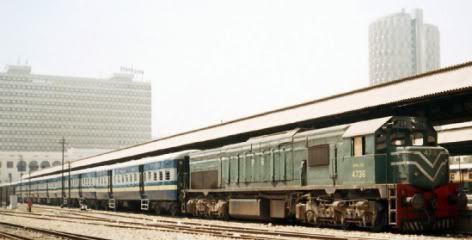
The above photo is courtesy of Adnan Zafar. It shows a KCR train at Karachi City station in 2006.
I’ve read people proposing to take the track underground from ‘teen-hatti bridge to Merewether tower’ because the road width is narrower on this section. That will be an even more expensive solution.
The Engineering Consultants International (ECIL) Plan for KCR:
Few years ago, a private firm Engineering Consultants International (ECIL) was hired by Government of Sindh and they proposed a three phase plan of providing rail and road based Mass Transit for Karachi.
Phase-1: consists of the rehabilitation of the KCR which includes the doubling of tracks between Karachi Cantt Station and Landhi Jn so that the KCR can have its own tracks and as such be completely independent of Pakistan Railways.
This phase also envisages the shifting of railway stations to under flyovers bridges at the intersections of major roads with the circular railway. This will facilitate interchange of transport modes and will firmly link the railway system with the road network.
Phase-2: of the master plan envisages the building of a loop from the Nazimabad Station through the Nazimabad Town, New Karachi Town and Gulshan-i-Iqbal Town to Depot Hill near the Drive-in Cinema.
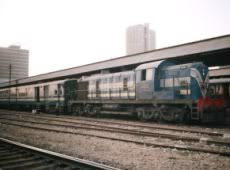
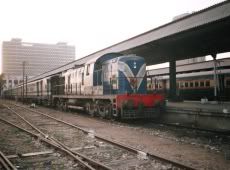
The above photos are courtesy of Adnan Zafar. KCR Trains at Karachi City Station in 2007.
The Phase 2 plan also includes the building of a spur to Orangi Town and the completion of a loop from Baloch Colony to Korangi and Landhi. A connection with the Quaid-i-Azam International Airport has also been planned.
Phase-3: of the master plan envisages a loop through Keamari Town and an extension of the Korangi line into Defence Society and its link up with the Shireen Jinnah Colony and the beach.
Looks like what we are getting with current project is a mixture of ECIL phase I and phase II (6 km airport link).
An All-Phase Map of KCR
Following map is one of the most circulated map of KCR on the internet. It is sketched by Adnan Zafar. It is not an official KCR plan but Adnan sketched the routes himself, taking the most optimistic approach. It combines the Karachi Mass Transit Plan (KMTP) with the ECIL proposal of KCR revival given to Sindh Governement.
Clicking on the map below will take you to its larger image.
Stake Holders:
There are 9 stakeholders of the KCR. Among them, the Sindh chief secretary and the transport secretary represent the Sindh government; the Karachi nazim and his one nominee represent the City District Government Karachi (CDGK), four officials represent the Pakistan Railways and one nominee represents the private sector.
Pakistan Railways will be owner of the KCR with 60% shares while the Sindh government has 25% shares and the CDGK is a 15% shareholder.
After completion, the system will be handed over to some internationally reputed firm (unknown to me at this time) which will operate the system and also bear the responsibility of KCR operation and maintenance.
The photo above shows a KCR Train ready to pull out of Karachi Cantt Station in 2006. Photo Credits: Adnan Zafar
Encroachments on the KCR Land:
 One of the biggest hurdle that stake holders will face in the revival of KCR is going to be removing of encroachments from the track.
One of the biggest hurdle that stake holders will face in the revival of KCR is going to be removing of encroachments from the track.
The photo to the right appears in Jang of October 14, 2008 and shows the KCR track in Nazimabad area getting covered by shrubs.
On the map Pakistan Railways owns 260 feet wide land corridor all along the KCR track but over the years not only the land mafia has grabbed railway land and build homes closer and closer to the track. Some of these structures consist of Reinforced Concrete (RCC). The track itself has been dilapidated at places, stolen to be sold as scrap, covered by shrubs and waste refuse has been dumped onto it from the nearby homes. The bridges of KCR are now used as pedestrain bridges by people to cross a number of nullahs and sewage streams that criss cross the city. Some bridges are also used for pleasure diving into raw sewage as seen in one of the photos below:
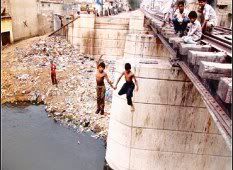

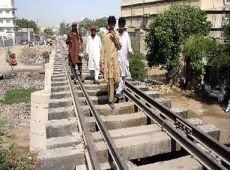
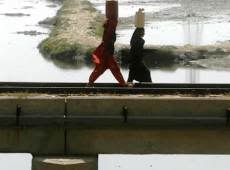
What Happened to The Anti Encroachment Drive of 2005?
A partial anti-encroachment operation was carried out on April 28, 2005 to remove encroachments from the KCR track but it was soon stopped due to political pressures, even though the directive to revive KCR had come directly from the then Prime Minister Shaukat Aziz.
At that time Government tried to vacate 140 ft wide corridor along the track (70 ft each side) and from 70 ft to 130 ft width on each side, it tried to regularize the structures if they paid the penalty at the rate of Rs 3000 per square yard. Some people did get their illegal structures legalized that way but I am not sure what happened further. I know the KCR track is still heavily encroached upon.
Look at the photos below which show some of the encroachments around KCR track. Look at the bottom left photo. Track is almost completely covered by wild shrubs and garbage. Photo at bottom left is from the partial anti-encroachment drive of 2005 with a stall called ‘Owais Paan shop’ getting moved too.
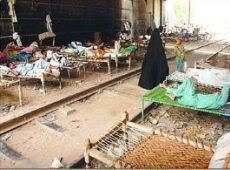


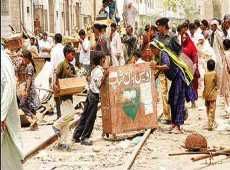
Trivia about KCR
(1) Gilani Railway Station:
Some of our readers may know that during PPP’s first government in 1975, Gilani Station in Gulshan-e-Iqbal was proposed to be developed as the Central Rail Terminus of Karachi. That plan never materialized.
(2) Governer of Sindh’s VIP Train at KCR Loop:
In 2005 Governer of Sindh also tried to visit the KCR loop in a special train but even this VIP train couldn’t complete the loop as encroachments came too close to the track.
Assorted KCR Photos From the 1980s
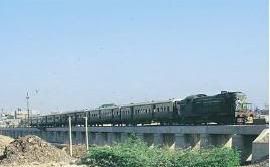 Following is an assortment of KCR trains and infrastructure photos from late 1980s. That was the time when KCR was fast going down. That fact should be obvious from some of the following photos too.
Following is an assortment of KCR trains and infrastructure photos from late 1980s. That was the time when KCR was fast going down. That fact should be obvious from some of the following photos too.
The photo above shows a KCR train on the bridge of a Lyari river tributary as it appraches the Lyari Railway Station.
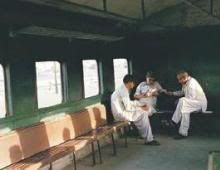
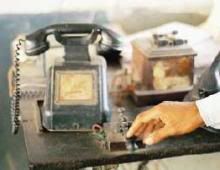
The photo above to the left shows an empty KCR coach with the only passengers present there playing cards. Photo to the right above is even more depressing (should I also say nostalgic). It shows the inter-station communication of KCR network which consisted of archaic phone sets and Morse Code circuitry.
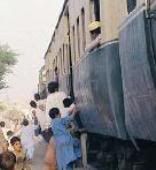 Photo to the left shows how popular was KCR service among children playing truants. Also notices how unclean the coaches of the train were. It looks like they were seldom ran through washing lines. Before KCR completely died down, the trains had become a favourite past time of students not wanting to go to schools and passing time taking free train rides.
Photo to the left shows how popular was KCR service among children playing truants. Also notices how unclean the coaches of the train were. It looks like they were seldom ran through washing lines. Before KCR completely died down, the trains had become a favourite past time of students not wanting to go to schools and passing time taking free train rides.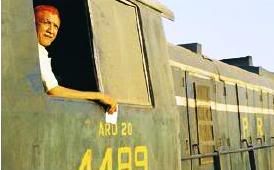 The photo to the right shows an old timer engineer (driver) in the cabin of ARU20 # 4489. Note how unclean the engine windows are. They don’t look transparent at all.
The photo to the right shows an old timer engineer (driver) in the cabin of ARU20 # 4489. Note how unclean the engine windows are. They don’t look transparent at all.
Following four photos are self explanatory. The lady vendor on a platform is Lyari Railway Station.

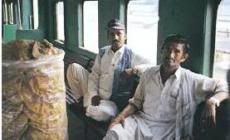

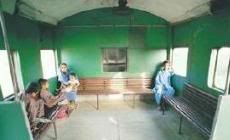
Stations of Karachi Circular Railway Network
Following is a list of 38 stations currently located in jurisdiction of Karachi city and which have been fed by Karachi Circular Railway at some point in time.
Main Line:
1. Kiamari 0 km
2. Karachi City 5 km
3. D.C.O.S (Halt)
4. Karachi Cant 9 km
5. Chanesar (Halt)
6. Departure Yard
7. Karsaz (Halt)
8. Air Force (Halt)
9. Drigh Road Jn 19 km
10. Drigh Colony Jn 21 km
11. Malir Colony Jn 24 km
12. Airport 25 km
13. Malir (Halt) 26 km
14. Landhi Jn 29 km
15. Jumma Goth 35 km
16. Bin Qasim 43 km
17. Badal Nala
18. Marshalling Yard Pipri
19. Gaddar
20. Dabheji 61 km
The Loop:
2. Karachi City
21. Port Trust (Halt)
22. Wazir Mansion
23. Lyari
24. Baldia
25. Shah Abdul Latif
26. S.I.T.E
27. Manghopir
28. Orangi
29. North Nazimabad
30. Liaqatabad
31. Gilani
32. Urdu College (Halt) – now Urdu University
33. Karachi University
34. Depot Hill Jn
9/10. Drigh Road Jn / Drigh Colony Jn
Malir Colony Jn -Malir Cant Branch:
11. Malir Colony Jn
35. Matapan (now called Mehran)
36. Model Colony
37. Malir Cantt
Landhi Jn – Korangi Branch:
14. Landhi Jn
38. Korangi
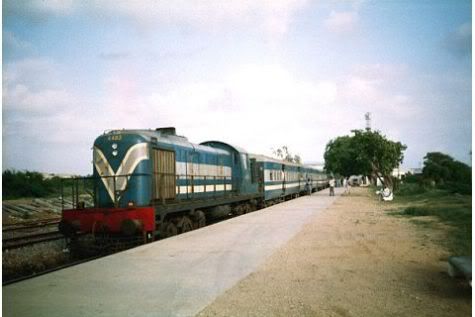
The photo above shows a KCR Train at Dabheji Station in 2006-07. Dabheji is also the last (or first) station of KCR network on Main Line. Photo is Courtesy of Adnan Zafar.
Chronology of Karachi Circular Railway:
1964: Work started on building first phase of KCR. In the first phase of construction, the circular railway track was initiated from the Drigh Road Railway Station, located on the main railway line, routed through the urban localities of Liaquatabad, Nazimabad and concluded at the Wazir Mansion Railway Station at Lyari.
1968-1969: The second phase of KCR was started. The track was extended from the Wazir Mansion and connected with the Karachi City Railway Station
1969: Karachi Circular Railway was opened for public.
1972: A proposal was submitted to the governement for building an underground train network from Merewether Tower to Jahangir Road. This proposal never saw light of the day.
1977: A plan was made for Karachi Mass Transit system that envisaged the development of a circular railway with branch lines into the suburbs like a system of arteries. In addition, there was to be a part-subterranean, part-elevated spine that bisected the circle. This way, Saddar and other residential areas would have been linked to the commercial centers. This plan was later shelved.
December 15, 1999: After serving the city populace for 30 years, Karachi Circular Railway got closed down.
March 18, 2003: Government of Sindh sets up a committee to look into the revival of KCR.
March 8, 2005: Karachi Circular Railway restarts its operation on a limited scale. 5 up and 5 down trains are started on main line with the longest route between Karachi City and Landhi Jn.
April 28, 2005: An operation was started to remove encroachments from the KCR Track land.
May 19, 2005: Karachi Circular Railway service extended to Wazir Mansion station. The service now runs between Wazir Mansion and Dabheji stations.
September 17, 2008: The Central Development Working Party (CDWP) an entitiy of Government of Pakistan approves Rs 52.372 billion for the revival of KCR.
September 3, 2009:The Executive Committee of the National Economic Council (Ecnec) approves the Karachi Circular Railway project at a cost of Rs128.60 billion.
December 15, 2009: The KCR train running between Karachi City and Malir Cantt is shut down until further notice.
Following photo shows state of encroachment on KCR track in 2009.

KCR VIDEOS:
KCR Loop Photos from December 2009:
I took both of the following photos on December 23, 2009. Both photos are taken from Gharibabad crossing. First photo is looking westward to Liaqatabad station and second photo is looking eastward towards Gilani station. One can see the terrible rot that has set in on this abandoned infrastructure. People have started dumping trash, building material on the tracks. One can see animals tied near the tracks. In bottom photo track is totally invisible, buried under dirt road on which a Suzuki can be seen plying.
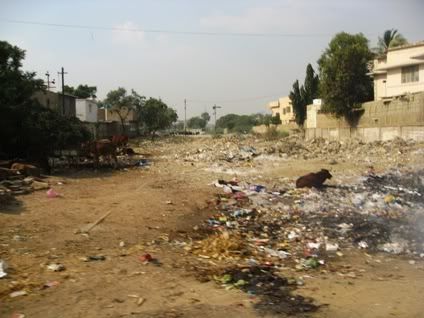
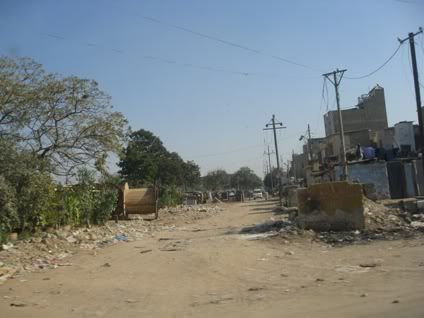
References:
1. KCR Revival Awaitng ECNEC Approval: Dawn, September 23, 2008
2. Karachi Railway Among 51 Projects Approved: Dawn, September 18, 2008
3. Operation to Clear KCR Land Launched: Dawn, April 29, 2005
4. Karachi’s Mass Transit System by Anwar Mooraj, March 24, 2003
5. 2004 to 2007 Updates on KCR revival by Adnan Zafar
6. Revival of Karachi Circular Railway: analysis by Arif Hasan. Dawn, January 1, 2002.
7. Proposed KCR design changes set to increase cost by Bhagwandas. Feb 28, 2009
8. Green Signal for KCR, September 3, 2009
9. KCR article at dawn.com on September 14, 2009
10. KCR on Track – Dawn Editorial on December 30, 2009
11. Karachi Mass Transit – Collection of KMTP related articles by Hassan Shirawani.
ATP’s Posts on Pakistan Railway:
1. Khyber Pass Railway
2. Bolan Pass Railway
3. The Trans-Balochistan Railway
4. Changa Manga Forest Railway
5. Lansdowne Bridge, Sukkur
6. Railway Bridge on Indus at Attock
7. Khojak Tunnel
8. Chappar Rift
9. Karachi Circular Railway – Revival gets 1 step closer
10. Zhob Valley Railway (ZVR)
11. How the First Locomotive Reached Lahore
12. 3000hp Iron Horses of Pakistan
13. Karachi Tramway of Yesteryears
14. Lahore Rapid Mass Transit Rail Project
15. A Phoenix Rises From the Ashes of Bakhshapur
16. ek masla hai… A Railway Runs Through It
17. Ava Gardner in Lahore for Bhowani Junction
18. The Meter-Gauge of Sindh
19. Indus Flotilla Company
20. Karachi to Kotri: First Railways in Pakistan
21. Pakistan Railway on the West Bank of Indus
Pakistan Railway Discussion Group:
If you want to learn more about Pakistan Railways, then feel free to join the ‘Pakistan Railway (PR)’ discussion group. Everything and anything related to PR is discussed here e.g. preserving of Pakistan’s rail heritage, steam locomotives, sharing of photos and news, time tables etc. You can join the discussion group here.
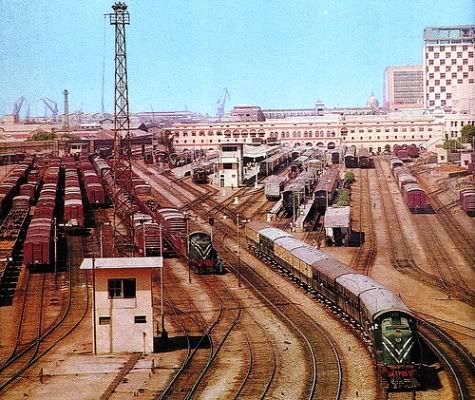
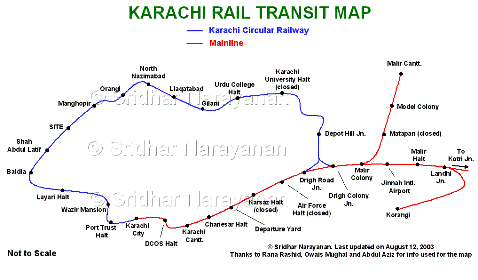
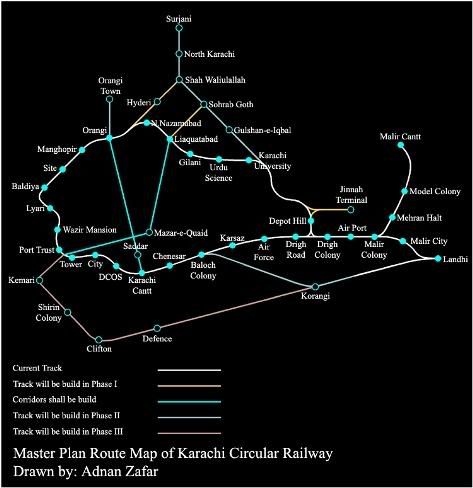
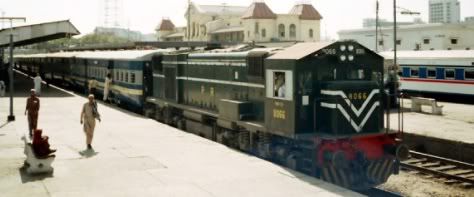



















































Finally some stir is seen in this project. 4650 families that would be affected because of this project will be given plots at an alternate site. This resettlement plan is now approved by the donors. The article below also provide interesting specifications of the project – as told by the chief of the Karachi Urban Transport Corporation (KUTC)
http://www.dawn.com/2011/08/07/kcr-resettlement-pl an-finalised.html
KCR revival is in news again. See here
Dawn news on latest snag that has now hit KCR. This time it is the land transfer issue between Federal Govt and Sindh’s Provincial Govt. Read here: